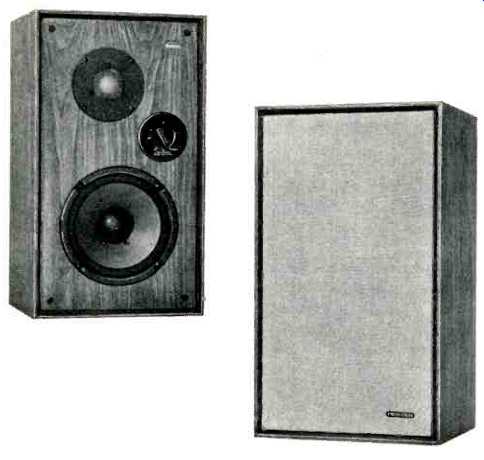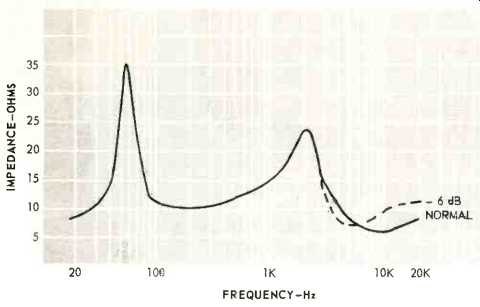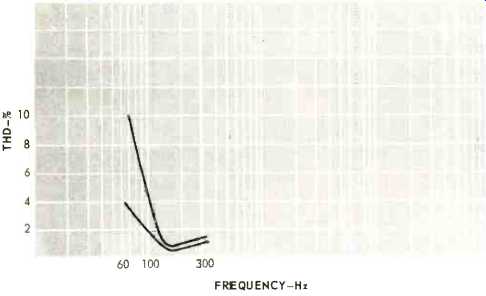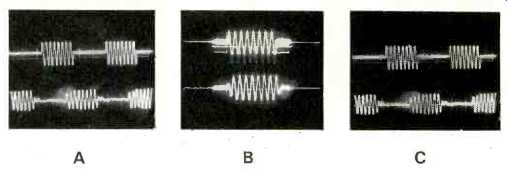
MANUFACTURER'S SPECIFICATIONS
System Type: Two-way, air-suspension.
Speaker Components: Two; woofer, 8-in. cone type; tweeter, 1-in. dome type. Nominal Input Impedance: 8 ohms.
Frequency Response: 35 to 20,000 Hz.
Sensitivity: 89 dB/W at one meter distance.
Maximum Input Power: 30 watts.
Crossover Frequency: 2,800 Hz.
Dimensions: 20 1/8 in. H by 11 1/2 in. W by 71 in. D.
Weight: 23 lbs.
Price: $79.95.
Here's a nifty small speaker system from Pioneer, a full line audio component manufacturer noted primarily for its receivers and amplifiers. The Model CS-E400 is a handsomely finished and a versatile performer.
To begin with, the loudspeaker enclosure is walnut finished on all six sides, which includes the front surface, where the speaker units themselves are mounted behind the removable beige grille cloth panel. There's something very racy in seeing the woofer cone and wire-covered tweeter dome mounted on a finished walnut panel, but we doubt that many will want to leave the grille cloth off for very long periods. The input terminals are recessed into the rear of the enclosure, while the tweeter control is recessed into the front. With greater emphasis on the search for flatter frequency response in the listening room, as evidenced by the increased use of equalizers and the like, we think that most users will find the front mounted speaker adjustment controls are more convenient to use than the more conventional rear-mounted ones, and we hail this up-front location in the Model CS-E400. This bookshelf-size speaker from Pioneer has a well-made conventional 8-in. acoustic suspension woofer. The 1-in. dome type tweeter is made of especially treated wool fibers, which, according to Pioneer, results in improved high end performance.
Measurements

Fig. 1--Frequency response to 1-octave band pink noise. Curve A was measured
from four feet, on axis. The upper treble-area curve is with "normal" tweeter
setting; the lower with "-6 dB" setting.
Curve B is response at 45° off-axis. Curve C is a composite of five curves,
taken both on and off axis.

Fig. 2--Impedance throughout the frequency range, shown at two settings of
the tweeter level control.

Fig. 3--Low frequency harmonic distortion at 95 and 100 dB SPL. Distortion
is mainly of the second harmonic.

Fig. 4--Tone burst response at A, 100 Hz; B, 1000 Hz, and C, 10,000 Hz.
Our standard set of tests at four feet revealed the Model CS-E400 to be a good performer overall. It has low harmonic distortion, the major portion of which occurs in the second harmonic, coupled with above average efficiency as its most significant attributes. The frequency response curve of Fig. 1A shows the unit to be within +/-6 dB from 40 to 14,000 Hz on axis and not significantly different off axis, as shown in Fig. 1B. The averaged response curve, Fig. 1C, shows a small audible dip at 2,500 Hz, which is around the crossover point and smack in the middle of the "presence" region. The impedance curve of Fig. 2 shows this as a corresponding peak, as well as the speaker's bass resonance at 60 Hz. The highs are fairly extended and non-directional. The speaker begins to roll off sharply at 60 Hz, which is to be expected from such a small box with relatively high efficiency. Input of 1.5 volts produced an 85 dB sound pressure level out at four feet, which is indeed efficient compared to other acoustic suspension bookshelf designs. It means that an amplifier with 20 watts rms power per channel will do nicely in driving the speaker in an average room. Its transient response was excellent, as can be seen in the toneburst photos of Fig. 4.
Listening Tests
In listening tests, the speaker had a clean, open sound, without the usual presence peak associated. Optimum balance in our room was with treble control set to the "-6 dB" position.
The dip in the presence region is to be preferred to the usual rise since most recorded material suffers from excess brightness in this part of the frequency spectrum. We recommend this speaker to the audiophile who must work within the confines of a limited budget.
-Alex Rosner
=================
(Audio magazine, Aug. 1972)
Also see:
Pioneer CSR 300 speaker (Equip. Profile, Feb. 1973)
Pioneer TZ-9 Speaker (Equip. Profile, Jun. 1990)
= = = =